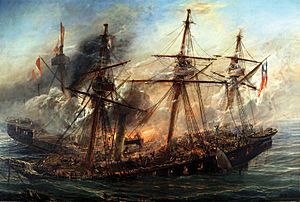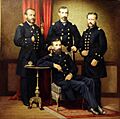Miguel Grau Seminario facts for kids
Quick facts for kids
Miguel Grau Seminario
|
|
|---|---|
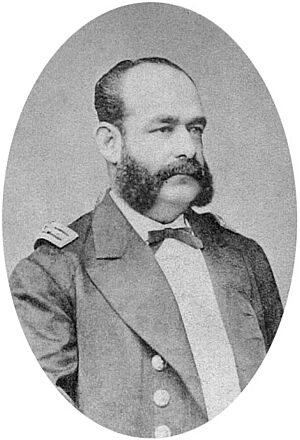
Seminario photographed by Eugenio Courret at the time of the War of the Pacific, c. 1879-84
|
|
| Birth name | Miguel María Grau Seminario |
| Born | 27 July 1834 Paita, Department of Piura, Peru |
| Died | 8 October 1879 (aged 45) Mejillones, Litoral Department, Bolivia (modern-day Antofagasta Province, Chile) |
| Buried |
Escuela Naval del Perú, Callao
|
| Allegiance | |
| Service/ |
|
| Years of service | 1853-1862 1864-1879 |
| Rank | Rear admiral Grand admiral (posthumously) |
| Battles/wars | Peruvian Civil War of 1856–1858
|
Miguel Grau Seminario (born July 27, 1834 – died October 8, 1879) was a brave Peruvian naval officer. He is famous for his role in the naval battle of Angamos. This battle happened during the War of the Pacific (1879–1884). People called him el Caballero de los Mares, which means "Gentleman of the Seas." He earned this name because he was always kind to his defeated enemies. Both Peruvians and Chileans respect him greatly. He is a true hero for the Peruvian Navy.
Contents
Miguel Grau's Early Life and Sea Adventures
Miguel Grau was born in Paita, Peru, on July 27, 1834. His father, Juan Manuel Grau y Berrío, came from Colombia. He fought with Bolivar for Peru's independence. Juan later bought land in Paita and worked at the Customs Office. Miguel's mother, María Luisa Seminario y del Castillo, loved the sea. She encouraged Miguel to love it too from a young age.
Miguel started sailing when he was just nine years old. His first trip was to Colombia on a merchant ship. The ship sank near Gorgona Island, but Miguel was not scared. He returned to Paita and went back to sea the next year. He sailed on many merchant ships. He visited ports in Oceania, Asia, America, and Europe. These trips gave him great experience. This experience helped him become a brilliant naval officer.
In 1853, when he was 19, Miguel Grau joined the Peruvian Navy. He quickly became known for his excellent skills. In 1854, he served as an officer on the steamer Rimac. His career moved forward very fast.
He left the Navy for a short time in 1862 to work in private business. But he returned in 1864. He was sent to Europe to help build new ships for Peru. One of these ships was the ironclad Huáscar. It was built in 1865 in England.
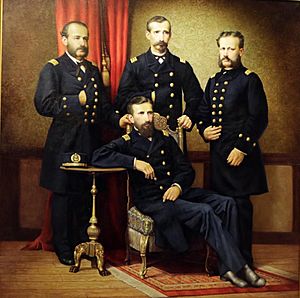
In 1868, he was called back to the Navy. He became the commander of the Huáscar with the rank of Lieutenant Commander. He was later promoted to commander. By 1874, he was the commanding officer of the entire Peruvian Navy fleet. He also became a member of the Congress of the Republic of Peru in 1876. He represented his hometown, Paita. Even today, his seat in Congress is kept empty. His name is called at the start of each session, and all congressmen respond "present."
Miguel Grau in the War of the Pacific
The War of the Pacific started on April 5, 1879. It was a conflict between Chile and a team of Bolivia and Peru. Miguel Grau was the captain of the Huáscar and the Commander of the Navy.
Grau showed amazing skill at sea. He stopped Chile's supply lines and communication. He damaged, captured, or destroyed several enemy ships. He also attacked enemy ports. The Huáscar became famous for its stealthy moves. It would strike by surprise and then disappear. These actions delayed Chile's sea invasion for six months. Because of his success, Grau was promoted to rear admiral. This was a very high rank.
Why Was He Called the Gentleman of the Seas?
At the Battle of Iquique, the Huáscar sank the Chilean ship Esmeralda. After the battle, Grau ordered his crew to rescue the Chilean sailors who survived. He also wrote a letter to the widow of the Chilean captain, Arturo Prat. He sent back Prat's sword and personal items.
Here is part of the letter he wrote:
- Dear Madam:
- I have a sacred duty that allows me to write to you. I know this letter might make your pain deeper, by reminding you of recent battles.
- During the naval fight in Iquique, on the 21st of last month, your brave husband Captain Mr. Arturo Prat, Commander of the Esmeralda, became a victim of his great courage. He died defending his country's flag.
- I am truly sorry for this sad event and share your sorrow. I must send you some of his belongings. They are very valuable to you. I hope they bring you a small comfort in your sadness. I have sent them to you quickly.
- I offer my deepest sympathy and my services to you.
- (Signed) Cpt. Miguel Grau
In another event, at the port of Antofagasta, Grau surprised an enemy ship called the Matias Cousiño. Before firing, he politely asked the crew to leave their ship. These actions, along with his brave fighting, earned him the nickname El Caballero de los Mares ("Gentleman of the Seas") from his Chilean opponents. They respected his extraordinary kindness and gentlemanly behavior.
Grau also played a key role in capturing the steamer Rimac. The Rimac was being chased by another Peruvian ship, the Union. When the Huáscar appeared and fired its cannons, the Rimac quickly surrendered. A whole cavalry regiment was captured with the ship. This was a big loss for the Chilean government.
How Miguel Grau Died at Angamos
Admiral Grau was killed during the Naval Battle of Angamos on October 8, 1879. His ship, the Huáscar, was fighting against four Chilean ships. An armor-piercing shell from the ironclad Almirante Cochrane hit the Huáscar.
The Huáscar was captured by the Chileans after a fierce battle. Most of Grau's body was not found. His remains were buried in Chile with military honors. In 1958, they were returned to Peru. For many years after his death, his name was called out in a special roll-call in the Peruvian Navy. The Peruvian Congress still does this today.
His final resting place is in an underground tomb. It is located at the Escuela Militar Naval del Peru in El Callao. In 1967, the Peruvian Congress honored him. They gave him the rank of Gran Almirante del Perú (Grand Admiral of Peru) after his death. A picture of Admiral Grau is on display in the museum ship Huáscar.
Miguel Grau's Lasting Legacy
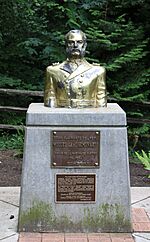
In the year 2000, people voted Miguel Grau the "Peruvian of the Millennium." This shows how much he is still admired.
In December 2019, the Peruvian Navy gave a bust of Grau to the United Kingdom. It was placed in Wirral, England. This honored the historical naval connections between Peru and Birkenhead. Birkenhead is where the Huáscar ship was built. The bust is now displayed in Birkenhead Town Hall.
A new memorial for Grau was revealed in Wirral in February 2024. It is on the promenade in Birkenhead, near where the Huáscar was built. This part of the promenade was also renamed Grand Admiral Miguel Grau Walk.
In Lima, Peru, a square and a metro station are named after him.
Images for kids
See also
 In Spanish: Miguel Grau para niños
In Spanish: Miguel Grau para niños


